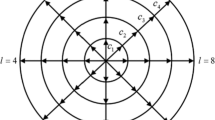Abstract
The motivation of this study is to investigate the turbulence–chemistry interactions by using probability density function (PDF) method. A consistent hybrid Reynolds Averaged Navier–Stokes (RANS)/PDF method is used to simulate the turbulent non-reacting and reacting flows. The joint fluctuating velocity–frequency–composition PDF equation coupled with the Reynolds averaged density, momentum and energy equations are solved on unstructured meshes by the Lagrangian Monte Carlo (MC) method combined with the finite volume (FV) method. The simulation of the axisymmetric bluff body stabilized non-reacting flow fields is presented in this paper. The calculated length of the recirculation zone is in good agreement with the experimental data. Moreover, the significant change of the flow pattern with the increase of the jet-to-coflow momentum flux ratio is well predicted. In addition, comparisons are made between the joint PDF model and two different Reynolds stress models.
Similar content being viewed by others
References
Pope S.B. (1985). PDF methods for turbulent reactive flows. Prog. Energy Combust. Sci. 11: 119–192
Pope S.B. (1995). Particle method for turbulent flows: integration of stochastic model equations. J. Comput. Phys. 117: 332–349
Xu J., Pope S.B. (1999). Assessment of numerical accuracy of PDF/Monte Carlo methods for turbulent reacting flows. J. Comput. Phys. 152: 192–230
Correa S.M., Pope S.B. (1992). Comparison of a Monte Carlo PDF finite-volume mean flow model with bluff-body Raman Data. Proc. Combust. Inst. 24: 279–285
Haworth D.C., Sherif H., Tahry E.l. (1990). Probability density function approach for multidimensional turbulent flow calculations with application to in-cylinder flows in reciprocation engines. AIAA J. 29(2): 208–218
Correa S.M., Gulati A. (1992). Measurements and modeling of a bluff body stabilized flame. Combust. Flame 89: 195–213
Saxena V., Pope S.B. (1998). PDF calculations of major and minor species in a turbulent piloted jet flame. Proc. Combust. Inst. 27: 1081–1086
Muradoglu M., Jenny P., Pope S.B., Caughey D.A. (1999). A consistent hybrid finite-volume/particle method for the PDF equations of turbulent reactive flows. J. Comput. Phys. 154: 342–371
Jenny P., Pope S.B., Muradoglu M., Caughey D.A. (2001). A hybrid algorithm for the joint PDF equation of turbulent reactive flows. J. Comput. Phys. 166: 218–252
Muradoglu M., Pope S.B., Caughey D.A. (2001). The hybrid method for the PDF equations of turbulent reactive flows: consistency conditions and correction algorithms. J. Comput. Phys. 172: 841–878
Muradoglu M., Liu K., Pope S.B. (2003). PDF modeling of a bluff-body stabilized flame. Combust. Flame 132: 115–137
Jenny P., Muradoglu M., Liu K., Pope S.B., Caughey D.A. (2001). PDF simulations of a bluff-body stabilized flow. J. Comput. Phys. 169: 1–23
Ge H.W., Zhu M.M., Hu G.H., Chen Y.L. (2002). Hybrid Finite-volume/particle method to solve joint PDF equations (in Chinese). J. Univ. Sci. Tech. China 32(5): 607–617
Zhu M.M., Ge H.W., Chen Y.L., Hu G.H. (2003). FV/MC hybrid algorithm for axisymmetric bluff body stabilised turbulent flows (in Chinese). Acta Mech Sinica 35(3): 332–336
Van Slooten P.R., Jayesh Pope S.B. (1998). Advances in PDF modeling for inhomogeneous turbulent flows. Phys. Fluids. 10(1): 246–265
Pope S.B. (1994). On the relationship between stochastic Lagrangian models of turbulence and second-moment closures. Phys. Fluids 6(2): 973–984
Pope, S.B.: Turbulent Flows. Cambridge University Press, (2000)
Gibson M.M., Launder B.E. (1978). Ground effects on pressure fluctuations in the atmospheric boundary layer. J. Fluid Mech. 86: 491–511
Launder B.E. (1989). Second-Moment closure and its use in modeling turbulent industrial flows. Int. J. Numer. Meth. Fluids 9: 963–985
Speziale C.G., Sarkar S., Gatski T.B. (1991). Modelling the pressure-strain correlation of turbulence: an invariant dynamical systems approach. J. Fluid Mech. 227: 245–272
Harle C., Carey G.F., Varghese P.L. (2000). Analysis of high speed non-equilibrium chemically reacting gas flows.Part II. A finite vlolume/finite element model and numerical studies. Int. J. Numer. Meth. Fluids 32: 691–709
Mohammadi, B.: Fluid dynamics computation with NSC2KE: An user-guide release 1.0. INRIA RT-0164, May (1994)
Debiez C., Dervieux A. (2000). Mixed-element-volume MUSCL methods with weak viscosity for steady and unsteady flow calculations. Comput. Fluids 29: 89–118
Roe P.L. (1981). Approximate Riemann solvers, parameter vectors and difference schemes. J. Comput. Phys. 43: 357–372
Poinsot T.J., Lele S.K. (1992). Boundary conditions for direct simulations of compressible viscous flows. J. Comput. Phys. 101: 104–129
Thompson K.W. (1987). Time dependent boundary conditions for hyperbolic systems. J. Comput. Phys. 68: 1–24
Pope S.B. (1994). Lagrangian PDF methods for turbulent flows. Annu. Rev. Fluid Mech. 26: 23–63
Muradoglu M., Pope S.B. (2002). Local time-stepping algorithm for solving probability density function turbulence model equations. AIAA J. 40(9): 1755–1763
Löhner R., Ambrosiano J. (1990). A vectorized particle tracer for unstructured grids. J. Comput. Phys. 91: 22–31
http://www.aeromech.usyd.edu.au/thermofluids/main_frame.htm
Dally B.B., Fletcher D.F., Masri A.R. (1998). Flow and mixing fields of turbulent bluff-body jets and flames. Combust. Theory Modell. 2: 193–219
Merci B., Dick E., Vierendeels J. (2001). Application of a new cubic turbulence model to piloted and bluff-body diffusion flames. Combust. Flame 126: 1533–1556
Author information
Authors and Affiliations
Corresponding author
Additional information
The project supported by the National Natural Science Foundation of China (50506028), and Action Scheme for Invigorating Education Towards the twenty-first century.
Rights and permissions
About this article
Cite this article
Zhu, M., Han, X., Ge, H. et al. Simulation of bluff body stabilized flows with hybrid RANS and PDF method. Acta Mech Sin 23, 263–273 (2007). https://doi.org/10.1007/s10409-007-0075-4
Received:
Revised:
Accepted:
Published:
Issue Date:
DOI: https://doi.org/10.1007/s10409-007-0075-4




